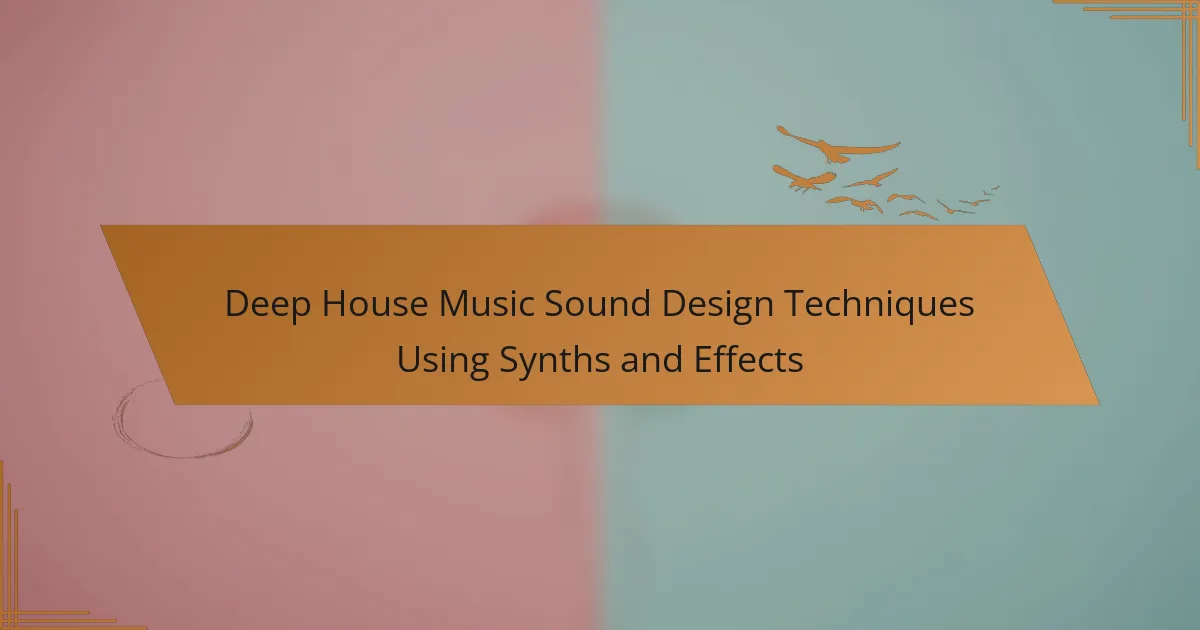Deep house music is characterized by its smooth and immersive qualities, achieved through specific sound design techniques. Key methods include layering multiple sounds for texture, modulation for movement, and the application of effects such as reverb, delay, and filtering to create atmospheric soundscapes. Synthesizers play an essential role in shaping the genre’s unique sounds, with techniques like sidechain compression enhancing rhythmic elements. This article outlines effective strategies for utilizing synths and effects, focusing on creating lush sounds, establishing warm foundations with pads, and experimenting with tempo variations to produce rich and dynamic deep house tracks.

What are Deep House Music Sound Design Techniques?
Deep house music sound design techniques include layering, modulation, and the use of effects. Layering involves combining multiple sounds to create a fuller texture. Modulation adds movement and variation to sounds, enhancing the overall depth. Common effects in deep house include reverb, delay, and filtering. These effects help to create an atmospheric soundscape. Synthesizers play a crucial role in shaping the unique sounds of deep house. Techniques such as sidechain compression are also frequently used to achieve a pulsing rhythm. These methods contribute to the genre’s signature vibe and emotional resonance.
How do synths contribute to deep house music sound design?
Synths play a crucial role in deep house music sound design by creating rich, layered textures. They generate a wide range of sounds, from lush pads to punchy basslines. These sounds are essential for establishing the genre’s atmospheric quality. Synths allow for extensive modulation, enabling producers to shape sounds dynamically. Techniques like frequency modulation and wavetable synthesis provide unique tonal characteristics. Additionally, synths can produce smooth, evolving sounds that enhance the emotional depth of tracks. The use of analog and digital synths contributes to the genre’s diverse sonic palette. Overall, synths are fundamental in crafting the signature sound of deep house music.
What types of synths are commonly used in deep house music?
Deep house music commonly utilizes synthesizers such as analog synths, digital synths, and software synths. Analog synths provide warm, rich tones that enhance the genre’s deep vibe. Popular models include the Roland Juno-106 and Moog Minimoog. Digital synths offer versatility and a wide range of sounds. Notable examples are the Yamaha DX7 and Korg M1. Software synths, like Serum and Massive, are widely used for their flexibility and ease of use. These synths allow producers to create lush pads, deep basslines, and intricate melodies, essential for deep house tracks.
How do different synth settings affect the overall sound?
Different synth settings significantly affect the overall sound by altering waveforms, filters, and modulation parameters. Waveform selection determines the harmonic content of the sound. For example, a sawtooth waveform produces a rich, bright tone, while a sine wave yields a softer, smoother sound. Filter settings control the frequency response, shaping the tonal quality. Low-pass filters can remove high frequencies, creating a warmer sound, while high-pass filters emphasize higher frequencies for a sharper tone.
Modulation settings, such as envelope and LFO adjustments, influence dynamics and movement in the sound. A fast attack and decay can create a punchy sound, while slower settings can produce a more sustained, evolving tone. Additionally, effects like reverb and delay can enhance spatial characteristics, affecting how the sound is perceived in a mix. These elements combine to create a unique sonic identity for each synth patch, essential in deep house music sound design.
What role do effects play in deep house music sound design?
Effects are crucial in deep house music sound design. They enhance the texture and atmosphere of tracks. Common effects include reverb, delay, and compression. Reverb adds depth and space, making sounds feel more immersive. Delay creates rhythmic interest and can build tension. Compression controls dynamics, ensuring a balanced mix. These effects contribute to the genre’s signature smooth and groovy sound. In deep house, effects also help to create emotional resonance. They shape how listeners experience the music, influencing mood and engagement.
Which effects are most popular in deep house music production?
Reverb, delay, and sidechain compression are the most popular effects in deep house music production. Reverb adds spatial depth and atmosphere to sounds. It creates a sense of space, making tracks feel more immersive. Delay enhances rhythmic elements and creates a fuller sound. It can be used creatively to build tension and interest. Sidechain compression is essential for achieving the characteristic “pumping” effect. It allows the kick drum to cut through the mix while controlling the dynamics of other elements. These effects are widely used in deep house tracks to create a rich and engaging listening experience.
How can effects be creatively applied to enhance sound design?
Effects can be creatively applied to enhance sound design by manipulating audio elements in innovative ways. Techniques such as reverb can create a sense of space and depth in a track. Delay can add rhythmic complexity and texture, making sounds more engaging. Distortion can introduce warmth and character, enriching the overall sound. Modulation effects like chorus or flanger can create movement and interest in static sounds. Filtering can shape frequencies, allowing for dynamic changes in tone and energy. Each effect can be automated to evolve throughout a track, adding layers of complexity. Using these effects thoughtfully can significantly elevate the emotional impact of deep house music.

How can you effectively use synths in deep house music?
To effectively use synths in deep house music, focus on creating lush, atmospheric sounds. Utilize pads to establish a warm foundation. Layer multiple synths to create depth and richness. Employ low-pass filters to soften sounds and enhance the groove. Use sidechain compression to create a pulsing effect, synchronizing with the kick drum. Experiment with modulation to add movement and complexity to synth lines. Incorporate reverb and delay for spatial effects, enhancing the overall ambiance. These techniques contribute to the signature sound of deep house music, characterized by its smooth and immersive qualities.
What are the best practices for sound design with synths?
The best practices for sound design with synths include understanding synthesis types, utilizing modulation, and layering sounds. Familiarity with subtractive, additive, and FM synthesis enhances creativity. Modulation through LFOs and envelopes adds movement and interest to sounds. Layering multiple synths creates a richer texture. Using effects like reverb and delay can enhance depth. Fine-tuning parameters such as attack and release shapes the sound’s character. Regularly experimenting with different presets can inspire new ideas. These practices contribute to a more dynamic and engaging sound design process in deep house music.
How can layering synths create a richer sound?
Layering synths creates a richer sound by combining multiple audio sources to enhance texture. Each synth can contribute unique timbres and frequencies. This approach allows for a fuller sonic spectrum. For example, a bass synth can provide depth while a lead synth adds brightness. Layering also enables the creation of complex harmonies. Different synths can be tuned slightly apart for a wider sound. Additionally, using varied waveforms can introduce distinct character. This technique is commonly used in deep house to achieve immersive soundscapes.
What techniques can be used for sound modulation in deep house?
Sound modulation in deep house can be achieved through various techniques. Common techniques include frequency modulation (FM), amplitude modulation (AM), and ring modulation. FM creates complex harmonic textures by altering the frequency of a sound wave. AM changes the amplitude of a sound wave, adding dynamic variation. Ring modulation combines two audio signals to produce new frequencies, enriching the sound palette.
Additionally, using LFOs (low-frequency oscillators) for modulation can create evolving soundscapes. LFOs can modulate parameters like filter cutoff or pitch, resulting in movement within the sound. Envelope modulation is also crucial, shaping the attack, decay, sustain, and release of sounds for dynamic expression.
Lastly, effects like reverb and delay can further modulate sounds, creating spatial depth and rhythmic variations. These techniques collectively enhance the sonic character of deep house music, making it more engaging and immersive.
How can you incorporate effects into your sound design process?
Incorporating effects into your sound design process involves using various audio processing tools to enhance your sounds. Start by selecting effects like reverb, delay, and distortion. These effects can create depth and texture in your tracks. Adjust parameters such as wet/dry mix and feedback to tailor the effect to your sound. Experiment with automation to change effect parameters over time. This adds movement and interest to your sound design. Layering different effects can also create unique sonic landscapes. For example, combining reverb with delay can result in rich, expansive sounds. Utilize EQ to carve out space for effects in the mix. This ensures clarity and balance in your final output.
What are the key considerations when choosing effects for deep house?
Key considerations when choosing effects for deep house include the mood, texture, and dynamics of the track. Effects should enhance the overall atmosphere without overpowering the core elements. Reverb adds depth and space, while delay can create rhythmic interest. EQ is essential for clarity, ensuring effects do not muddy the mix. Modulation effects like chorus or flanger can enrich sounds, adding movement. Compression helps maintain consistency in dynamics, especially for bass and drums. It’s crucial to consider the arrangement and how effects interact with each other. Ultimately, effects should serve the song’s narrative and emotional journey.
How can automation improve the use of effects in sound design?
Automation enhances the use of effects in sound design by allowing precise control over parameters. It enables gradual changes in effects like reverb, delay, and modulation. This control creates dynamic shifts throughout a track. For instance, increasing reverb on a vocal during a chorus adds depth. Automation can also adjust the intensity of effects in real-time. This results in a more engaging listening experience. Studies show that tracks using automation can maintain listener interest more effectively. Overall, automation provides flexibility and creativity in sound design.

What specific techniques can enhance your deep house music production?
Utilizing sidechain compression can enhance deep house music production. This technique creates a pumping effect by reducing the volume of one audio track in relation to another. It is commonly applied to the bass line and kick drum. The result is a rhythmic interplay that adds energy to the track. Layering synths with varying textures also improves depth. Using a combination of pads and leads creates a richer soundscape. Incorporating reverb and delay effects can further enhance the atmosphere. These effects add space and dimension to the mix. Finally, experimenting with tempo variations can help create unique grooves. A typical deep house track ranges from 120 to 125 BPM, allowing for flexibility in rhythm.
How can sound design techniques be tailored for deep house music?
Sound design techniques can be tailored for deep house music by focusing on specific sonic characteristics. Deep house often features warm, lush pads and deep basslines. Using synthesizers, designers can create rich, textured sounds that evoke a smooth atmosphere.
Layering multiple synths can enhance depth and complexity. Effects like reverb and delay can add spaciousness to the mix. Sidechain compression is commonly used to create a pulsing effect that drives the rhythm.
Utilizing samples of acoustic instruments can add organic elements to the tracks. Modulating parameters like filter cutoff can create movement within the sound. Finally, attention to the frequency spectrum ensures clarity and balance in the mix.
What are some unique sound design techniques specific to deep house?
Unique sound design techniques specific to deep house include the use of lush pads and ambient textures. These elements create a warm, immersive atmosphere. Sidechain compression is often applied to kick drums to achieve a pulsing effect. This technique enhances the groove and rhythm of the track. Additionally, deep house frequently utilizes vocal chops. These samples add a human element and emotional depth to the music.
Reverb and delay effects are commonly used to create space and depth. These effects help to blend sounds seamlessly. Filtering techniques, such as low-pass filters, are also prevalent. They shape the sound, giving it a smooth, mellow quality. Finally, the use of swing in drum programming adds a laid-back feel. This rhythmic variation contributes to the overall groove of deep house tracks.
How can you experiment with unconventional sounds in deep house music?
Experimenting with unconventional sounds in deep house music involves using non-traditional instruments and techniques. Incorporate field recordings or found sounds to create unique textures. Utilize granular synthesis to manipulate samples in innovative ways. Layer unexpected sounds, such as organic noises or vocal snippets, to add depth. Experiment with effects like reverb and delay to transform these sounds. Use unconventional time signatures or polyrhythms to create rhythmic interest. Explore different tuning systems or microtonality to shift the harmonic structure. These methods can lead to fresh and engaging deep house tracks.
What are some common challenges in deep house music sound design?
Common challenges in deep house music sound design include achieving a balanced mix, creating unique sounds, and managing frequency clashes. A balanced mix is crucial for clarity and depth in deep house tracks. Unique sound creation often requires extensive experimentation with synths and effects. Frequency clashes can occur when different elements occupy similar ranges, leading to muddiness. Additionally, replicating the warm, analog feel of classic deep house can be difficult with digital tools. Finally, maintaining listener engagement through dynamic sound design poses a continuous challenge.
How can you troubleshoot issues with synth sounds in your mixes?
To troubleshoot issues with synth sounds in your mixes, start by checking the synth settings. Ensure that the oscillators are tuned correctly. Verify the filter settings to avoid unwanted frequencies. Adjust the envelope settings for proper attack and release times. Check for phase cancellation by panning synths in different directions. Use EQ to cut problematic frequencies that clash with other instruments. Listen in mono to identify any stereo issues. Finally, reference your mix against professional tracks to gauge balance and clarity. Each of these steps addresses common problems encountered in synth sound design.
What tips can help beginners improve their sound design skills?
Beginners can improve their sound design skills by practicing regularly with various synthesizers. Experimenting with different waveforms and modulation techniques enhances creativity. Learning to layer sounds can create richer textures. Understanding EQ and its impact on clarity is essential. Using effects like reverb and delay adds depth and space. Analyzing tracks from established artists helps identify effective sound design techniques. Participating in online forums and communities provides valuable feedback and inspiration. Finally, utilizing sound design tutorials can accelerate learning and skill development.
Deep house music sound design techniques focus on the use of synthesizers and effects to create rich, immersive soundscapes. Key techniques include layering sounds, modulation, and applying effects such as reverb, delay, and sidechain compression. The article explores the role of different types of synths, their settings, and how effects can enhance the overall sound. Additionally, it addresses best practices for sound design, challenges faced in the process, and tips for beginners to improve their skills in deep house music production.
